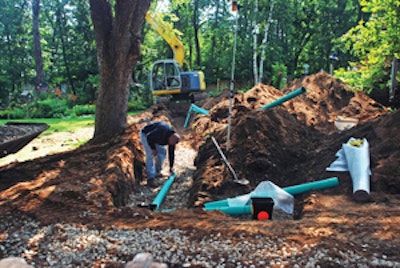Interested in Distribution?
Get Distribution articles, news and videos right in your inbox! Sign up now.
Distribution + Get AlertsFor this and the next few months, we will discuss soil treatment units, beginning with the most conventional: flow by gravity into a series of underground trenches or beds.
As we travel the country, we often see misconceptions about how these most basic systems work. So before we get into installation specifics, let’s spend a little time on an overview of the systems. We can then use that information as we move on to examine other more complicated systems.
Piping and rock
The system we are talking about consists of a piping network to receive septic tank effluent with rock or some other media to help distribute the effluent to the soil. The design of these systems must take into account the average daily sewage flow, the method of distribution between parts of the system, the soil conditions, and the required setback distances.
As an installer, you and the designer need to know about all of these aspects. You are the last person (besides the local inspector) in contact with the system, and therefore you become responsible if one of the necessary conditions is not met. Remember: You get the call if something goes wrong.
In a typical gravity soil treatment system that consists of treatment trenches, the effluent flows by gravity into a 4-inch pipe with 1/2-inch holes spaced 6 inches apart. The effluent flows down through the distribution media or rock to the soil. The rate at which effluent moves into the soil is affected by a number of factors: volume of effluent (daily flow); soil properties such as texture, structure and moisture content; depth from the soil surface; the size of soil pores (large or small), and soil consistency.
Building the biomat
As the effluent comes in contact with the soil surface, all the factors come into play to promote the formation of a layer called the biomat. The biomat is formed by microorganisms in the soil and the effluent. The organisms attach to the soil particles and media at the interface.
This, along with suspended organic solids, begins to reduce the infiltrative capacity of the soil where the effluent first contacts it. As the system is used, the biomat covers the entire bottom infiltrative surface. Effluent then begins to pond, and the biomat develops up the sidewalls.
The biomat acts as a valve to slow the flow of effluent into the soil. This creates and maintains unsaturated and aerobic conditions below and alongside the trench, maximizing the effluent’s contact time with soil particles in this highly biological zone.
It is here that the BOD and suspended solids are removed, and under these conditions, bacteria and viruses are held and prevented from moving away. This allows treatment to occur that removes these organisms. Maintaining an unsaturated aerobic zone around the trenches is the single most important factor to prevent transmission of pathogens.
In a mature gravity-fed system with the biomat formed on the bottom and the sidewalls, effluent will pond in the trenches – a natural result of biomat formation. It does not necessarily mean the system is failing. We would expect to see ponding in the trench while an area of a few inches along the side and on the bottom the soil itself remains unsaturated.
Effluent will then move out through both the trench bottom and the sidewalls. How much flows out the bottom versus out the sidewall varies over time, depending on the soil’s vertical and horizontal hydraulic conductivity, biomat resistance, and the soil moisture condition. That is why we often see that trenches work better when the weather is warmer and dryer.
Separation distances
This is also a part of the reason why separation distance to saturated soil conditions, such as periodic high water tables, is so important. If the bottom of the system is too near the water table, the soil is naturally moist, which means it holds less oxygen. This leads to a lack of oxygen for treatment and for bringing the biomat into equilibrium, making for a thicker, more resistant biomat, which can reduce flows to the point of failure.
So you have the double whammy in the sense that you do get inadequate treatment, leading to transmission of pathogens, and you also get system hydraulic failure. The contaminated waters can then move to deeper aquifers or to nearby lakes and streams.
As we will discuss in upcoming articles, these are soil conditions that you should be able to recognize, and one part of a good installation is to provide that separation. One comment we often hear from installers is, “Boy, I am glad the soils in my area are nothing but sand and gravel. I have no problem getting rid of the effluent, and I never see a biomat.”
Recognize that if the soil conditions are sandy or gravelly and the effluent moves too fast through those large soil pores, none of the treatment we’ve talked about occurs. That is because the flow through the soil pores is saturated, and the effluent does not have adequate contact time in the soil for treatment to occur.
Under these conditions, pathogens can move thousands of feet away from the system, potentially contaminating drinking water sources as well as nearby surface waters. This is why under sandy conditions your state code may place certain system restrictions on how sandy the soil can be and still use a septic-tank-to-drainfield gravity system.
For the finer-textured, less-coarse soils, recognize that the sizing factors we all use in system design are based on assuming the biomat will be present. We count on it to be present to assist in the treatment process. So as installers, we need to know what can be done to identify and enhance the conditions that will keep the system in balance, providing treatment while insuring that your clients’ toilets flush and the water moves away.







